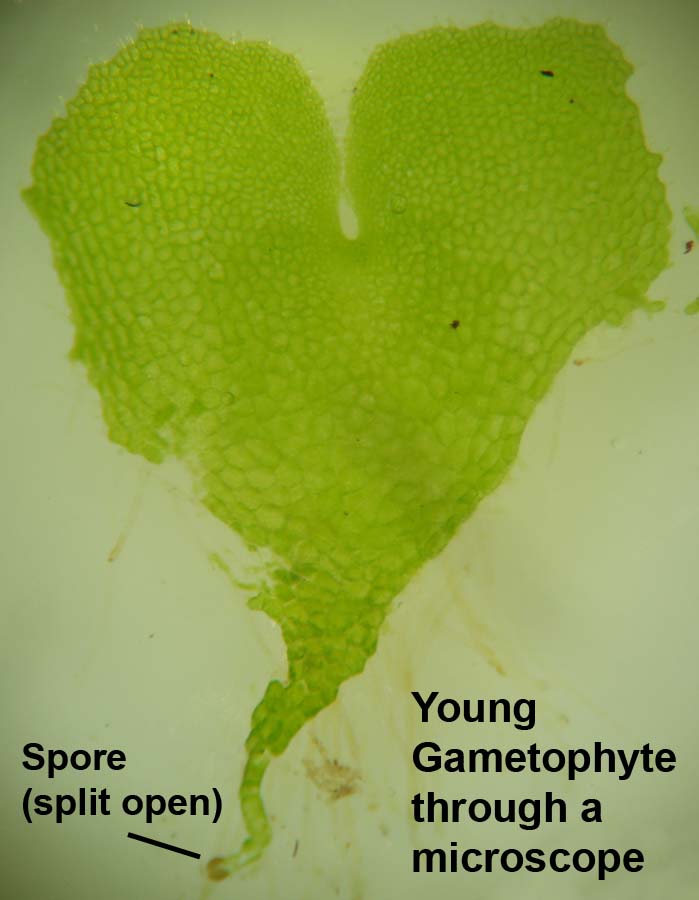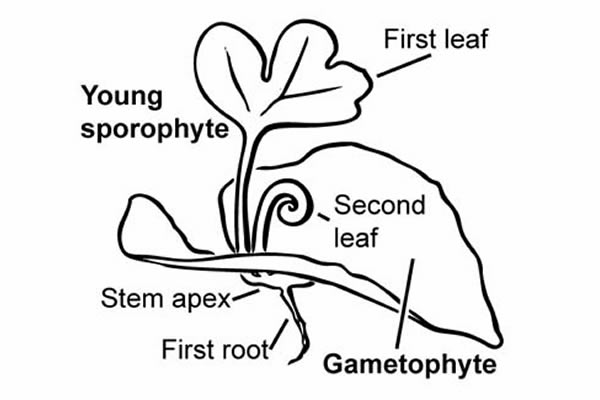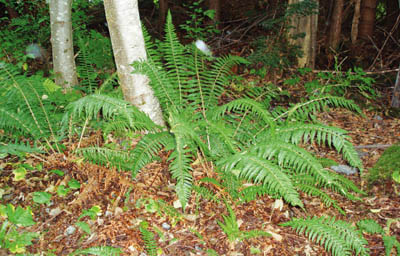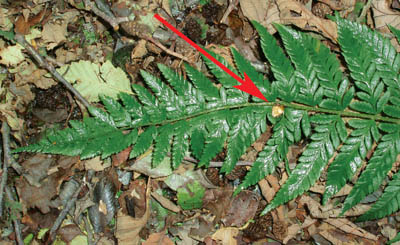Fern Reproduction
Reproduction by Spores
Ferns and horsetails have two free-living generations:
- a diploid sporophyte generation (spore-producing plant) and
- a haploid gametophyte generation (gamete-producing plant).
Plants we see as ferns or horsetails are the sporophyte generation. The sporophyte generally releases spores in the summer. Spores must land on a suitable surface, such as a moist protected area to germinate and grow into gametophytes.
The mature gametophyte of many of our ferns looks like a little flat green heart, about the size of a fingernail. Male and female reproductive structures develop on the lower surface of the same, or more often, on different gametophyte plants. At sexual maturity, the male structures release sperm that swim through the film of water of the moist habitat to fertilize the egg in the female structure. Horsetail gametophyte processes are similar, but they look more like little green ragged mounds.
Many gametophytes usually grow in close proximity to each other, and in most ferns and horsetails the sperm of one gametophyte is most likely to fertilize the egg of a different gametophyte. This fertilized egg develops into an embryo, which is the beginning of the diploid sporophyte generation. The first tiny leaf of the sporophyte emerges from the bottom of the gametophyte (which disintegrates) and grows upward and soon becomes a plant we see as a fern or horsetail.
You can grow ferns from spores. The American Fern Society describes how to collect spores and grow ferns from spores. You can also obtain spores from a wide variety of ferns from the American Fern Society.
Vegetative Reproduction
Bulblets and Fernlets
Bulblets are small vegetative buds that grow on the fronds of several fern species. When the bulblet is pressed to the ground or falls off the fern, it may take root and grow into a mature fern. Examples of ferns that can reproduce via bulblets are
Anderson’s holly fern of the Northwest coast produces a bulblet toward the tip of the frond. When pressed to the ground the bulblets grow into new plants; therefore, this fern often grows in colonies of plants of various ages as shown in this photo of a colony of Anderson’s holly fern.
Walking fern gets its name from its interesting way of creating new plantlets. Its simple fronds have long pointed tips. When these tips touch the ground, a new fern develops; thus, the fern “walks” across the landscape.
Rhizome (Stem) Growth
Ferns with creeping rhizomes spread as the rhizome grows above or below the substrate. Roots and leaves are produced near the tip of the elongating and branching rhizome. As the plant grows, the rhizome may break, separating segments of the fern. The separated segment lives because the rhizome is rooted along its length and bears leaves. A single fern can spread into a large colony of ferns. Many ferns spread this way, including oak fern, beech fern, ostrich fern, bracken fern, and common horsetail.
Growing Sword Ferns from Spores in the Dark Days of Winter
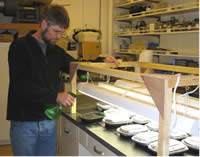 Spores of sword ferns (Polystichum) are germinating in special containers under controlled lighting, temperature and moisture conditions.
Spores of sword ferns (Polystichum) are germinating in special containers under controlled lighting, temperature and moisture conditions.
The Sitka Ranger District (Tongass National Forest), National Park Service, University of Alaska Cooperative Extension Service. and the U.S. Geological Survey are cooperating to grow sword ferns from spores as a component of a native plant propagation project. Sword ferns are showy ferns, valuable for landscaping or re-vegetation projects.
Four sword fern species are native to Baranof Island, where Sitka is located, and are adapted to a variety of habitats and transplant well. None of these large evergreen ferns is abundant enough to sustain commercial harvest. Propagation by spores may be a way of producing enough plants for restoration projects or use by local landowners. Simple protocols are being tested to grow the ferns. Spores were collected in the wild, sown on sterile soil in special covered containers. They are provided with light 12 hours a day and carefully misted to provide moisture. After three weeks the first tiny germinated ferns were visible. We hope to nurture these tiny bits of green into luxuriant adult ferns.


